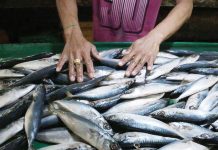
The world’s largest free trade pact forged by 15 Asia-Pacific countries entered into force Saturday to provide a tailwind for the region’s post-pandemic recovery and a catalyst for global economic progress, bringing a ray of hope.
The Regional Comprehensive Economic Partnership (RCEP) agreement groups 10 Association of Southeast Asian Nations (Asean) countries, as well as China, Japan, South Korea, Australia, and New Zealand, covering nearly a third of the world’s population and gross domestic product.
Given its size and terms, the RCEP is widely expected to bolster regional trade and investment flows and boost economic integration and prosperity in the region and beyond.
“The golden age of durian trade is coming,” said Edwyn Chiang, secretary general of the Malaysia International Durian Industry Development Association, expecting the RCEP to spur exports of the thorny “king of fruits” by 50 percent by the year 2030.
The RCEP will open a broader market and development space for Malaysia’s agriculture sector, strengthen the country’s agricultural product trade as well as the sector’s investment and cooperation with other member countries, Chiang said.
“This (RCEP) will not only present new opportunities for Malaysian businesses, but also for regional business communities tapping into RCEP to access Malaysian and Asean markets more broadly,” Malaysian Prime Minister Ismail Sabri Yaakob said.
The free trade bloc is expected to eventually eliminate tariffs on more than 90 percent of goods, expand market access for investment, harmonize rules and regulations, streamline customs procedures, and set common rules concerning the development of e-commerce as well as small and medium-sized enterprises, according to business insiders.
Asean Secretary-General Dato Lim Jock Hoi said the pact will “open up opportunities that could catalyze the expansion of regional trade and investment.”
“Under the RCEP agreement, the region will become a single production base as well as a market for its products,” he said.
‘Center of gravity for global trade’
The United Nations Conference on Trade and Development said the RCEP will create “a center of gravity for global trade,” expecting the agreement’s tariff concessions to boost exports within the region by USD42 billion.
Businesses with global supply chains might face tariffs even within a free trade area (FTA) if their products contain components that are made elsewhere.
Under the RCEP’s rules of origin, parts from any member country would be treated equally, which might give companies in RCEP countries an incentive to look within the region for suppliers, analysts said.
The RCEP’s tariff concessions, unified rules of origin and simplification of customs procedures “will enable our company to purchase raw materials and equipment as well as distribution of products more efficiently and at a lower cost,” said Qiu Jinliang, managing director of Himile (Thailand) Co., a tire mold supplier.
Li Yanqiang, chairman of Beibu Gulf Port Group in south China’s Guangxi Zhuang Autonomous Region, expected the RCEP to promote economic and trade cooperation within the region and increase the port’s container throughput.
Of the 44 shipping routes linking the port with overseas ports, 28 are connected to RCEP countries, Li said.
By 2030, the RCEP will increase the member economies’ incomes by 0.6 percent, adding USD245 billion annually and 2.8 million jobs to the regional economy, according to a study by the Asian Development Bank. (PNA)



